Last time I made "Figgy cranberry sauce", I could not get fresh or frozen cranberries and used dried and sweetened "Craisin". The other day, we were at a near-by Whole foods and I found frozen cranberries and decided to make figgy cranberry sauce from the frozen cranberries. I have never used frozen cranberries before. This time, I followed the recipe more closely and used orange peel during the cooking. We tasted the one I made from "crasin" and the one I made from"frozen cranberries" as an informal taste test. The consistency and the taste between them is a bit different but both are quite good. The frozen cranberry version is a bit more tart but has a fresh taste.
Ingredients:
Frozen cranberries (10oz bag) (Do not thaw).
Dried figs, coarsely chopped (1 cup)
Sugar 1/2 cup
White wine 3/4 cup
Orange peel, 2 long strips without pith
Salt, a pinch
Orange flavored liquor (I used triple sec), 2 tbs
Directions:
1. Soak the figs in hot water for 20 minutes.
2. In a sauce pan, add the wine and sugar on medium flame. Once it starts to boil reduce the heat and mix to dissolve the sugar.
3.Add, the cranberries, drained figs, orange peel and cook for 10 -15 minutes stirring occasionally until the sauce thickens.
4. Cut the flame and add a pinch of salt and the orange liquor and mix (I also added a bit of fresh orange juice since I had an orange from which the peel was made).
Below is after 10 minutes. You can see the sauce thickened.
Although finding frozen cranberries is a bit difficult (our regular grocery store did not have it), using it to make the figgy cranberry sauce is almost identical to the one made with fresh cranberries. The one I made from dried and sweetened "Crasin" is not bad either with less tart taste and a bit firmer consistency.
Showing posts with label Other. Show all posts
Showing posts with label Other. Show all posts
Monday, May 15, 2017
Wednesday, May 3, 2017
Figgy Cranberry sauce イチジク、クランベリーソース
I usually make some type of cranberry sauce during the Holiday season, although we no longer cook turkey. My first encounter with cranberry sauce was the "canned and jelled" kind. Later I learned it is very easy to make cranberry sauce from fresh cranberries and it is much better than the canned stuff. Last year, I made "figgy cranbery sauce" from a recipe I saw in the Washington Post. I did not post this and we finished eating it several months ago. It was a pretty versatile sauce, however, and went well with chicken or even pork. My wife asked me to make some more even though it was not the Holiday season. It may not be the Holiday season but it is also not the season for cranberries--none were to be had. My wife suggested I make a similar sauce using just dried figs and balsamic vinegar. But I thought it was essential to have cranberries in cranberry sauce and made this using dried mission figs and "Craisins", which are sweetened/flavored dried cranberries. I served the sauce with my "Matsukaze" chicken patties 鳥の松風焼き as an appetizer with a glass of red wine.
Despite using only dried fruit, the sauce came out pretty well and went perfectly with this chicken dish.
Ingredients:
Dried mission figs, coarsely chopped, about 1/2 cup (left below).
Craisins, about 1 cup (right below)
Japanese Yuzu citrus skin (frozen) about 1 tsp (or orange peel or zest)
Orange liquor (I used triple sec), 2 tbs
Sake (or white wine), 1/2 cup.
Directions:
Soak the figs and Craisins in hot but not boiling water (I used hot water from our InstaHot) and let them sit for 20-30 minutes. I drained the liquid reserving 1/4 cup.
In a sauce pan, I added sake and when it came to a boil added the drained figs and Craisins. I stirred and mashed the fruit. During this process I thought it may need more liquid and added the reserved soaking liquid. After 10 minutes or so, the sauce thickened. I tasted it and decided no sugar was needed (Craisins are rather sweet). Off the heat, I added the triple sec and Yuzu skin and mixed well.
This was a success! Without using any additional sugar, it was just right. The yuzu and triple sec added a nice burst of citrus flavor. Now I can make my figgy cranberry sauce any time of the year.
Despite using only dried fruit, the sauce came out pretty well and went perfectly with this chicken dish.
Ingredients:
Dried mission figs, coarsely chopped, about 1/2 cup (left below).
Craisins, about 1 cup (right below)
Japanese Yuzu citrus skin (frozen) about 1 tsp (or orange peel or zest)
Orange liquor (I used triple sec), 2 tbs
Sake (or white wine), 1/2 cup.
Directions:
Soak the figs and Craisins in hot but not boiling water (I used hot water from our InstaHot) and let them sit for 20-30 minutes. I drained the liquid reserving 1/4 cup.
In a sauce pan, I added sake and when it came to a boil added the drained figs and Craisins. I stirred and mashed the fruit. During this process I thought it may need more liquid and added the reserved soaking liquid. After 10 minutes or so, the sauce thickened. I tasted it and decided no sugar was needed (Craisins are rather sweet). Off the heat, I added the triple sec and Yuzu skin and mixed well.
This was a success! Without using any additional sugar, it was just right. The yuzu and triple sec added a nice burst of citrus flavor. Now I can make my figgy cranberry sauce any time of the year.
Monday, February 17, 2014
"Kuromame" black beans in Greek yogurt 黒豆の水切りヨーグルト和え
Kuromame 黒豆 or "black beans" are practically only eaten as part of the New Year’s dishes. Reportedly, it is not related to Western "black beans" but are a type of black soybean (Recipe in English is also found here). I have not ever prepared New Year’s black beans myself but instead bought them from the Japanese grocery store. More recently, they have been included in Sushitaro Osechi. Although we always enjoy kuromame on new year's day, we tend to forget we have kuromame and find them much later tucked in the back of the refrigerator. I saw an interesting recipe to use kuromame on the Internet and decide to try it.

I did not do a good job presenting this dish (some embellishment such as some parsley etc would have helped) but it is too late.

I used Greek yogurt (or you can drain regular yogurt to make “greek” yourself). Using my own instinct, I added a bit of good fruity olive oil and salt to the yogurt and mixed in the cooked black beans.
It tasted good but I mainly tasted the Greek yogurt. The black beans added texture and some sweetness in contrast with the sourness from the yogurt. This is a good way to finish off the kuromame .

I did not do a good job presenting this dish (some embellishment such as some parsley etc would have helped) but it is too late.

I used Greek yogurt (or you can drain regular yogurt to make “greek” yourself). Using my own instinct, I added a bit of good fruity olive oil and salt to the yogurt and mixed in the cooked black beans.
It tasted good but I mainly tasted the Greek yogurt. The black beans added texture and some sweetness in contrast with the sourness from the yogurt. This is a good way to finish off the kuromame .
Sunday, January 5, 2014
New Year "Osechi" from sushi Taro 寿司太郎のおせち料理
We have been feasting on Sushi Taro Osechi Boxes おせち料理 for three days and there is still some left. As usual we picked it up the boxes on the afternoon of December 31. We received two boxes or "Ju-bako" 重箱 neatly wrapped in "Furoshiki" 風呂敷 Japanese wrapping cloth as you can see below. Although this is the 3rd year we've gotten the Sushi Taro Osechi, it was still exciting to peek into the boxes to see what treats are inside.

This is a view of the upper box. Black beans (kuro-mame 黒豆) are in the jar (left upper corner) and steamed sea urchin is in the right upper corner. In the center is a small grilled red fish or "Tai" 小鯛の姿焼き and the right to that is beef tongue, Some items are hidden underneath.

This is the lower box. We love "ankimo" monkfish liver terrine (left upper) and this year, we got more of our favorite "karasumi" からすみ or Japanese bottarga (in the upper center). With these two items alone we can consume a lot of sake. The center row includes sake steamed prawns and chestnuts. The 3rd row contains simmered vegetables, duck breast and simmered octopus.

On New Year's Day, I made a plate with the combination of my dishes and the ones from Sushi Taro Osechi. Although, "Datemaki" 伊達巻き (yellow roll) was also in the box, I served the one I made from "Hanpen" はんぺん fish cake and eggs. Besides "matsukaze yaki" 松風焼き (left lower), salmon kelp roll 鮭の昆布巻き (behind Datemaki) and Kazunoko herring roe 数の子 (below Datemaki, the rest of the items are from the box. I added decorative cuts on the red and white fish cake 紅白蒲鉾. A big prawn was sake steamed and delicious.

Daikon Namatsu 大根なます was also included in the box but I served mine with Ikura salmon eggs and sweet vinear marinated octopus.

This is marinated "Russian" salmon with lemon and onion I made as usual from my mother's recipe.

The below are drinking snacks on January 2. These are all from the box. We had this with red wine. From the left, beef tongue, marinated egg yolk with Brasilian nuts (wonderful!), Sweet potato, Datemaki, Chestnut (shibukawa-ni 渋皮煮), Ankimo terrine (right upper), Daifuki mame beans 大福豆 and cherry petal nagaimo. All went well with the wine.

This could have been a lunch on the second. The left is small molded sushi with cured snapper, the front is my salmon kelp roll.

This could have been the 3rd day appetizers. Duck breast, marinated egg yolk, mustard stuffed burdock root, burdock root with sesame sauce, cumquat simmered in syrup, three rolled items on the right (from the top) are cod roe wrapped in kelp, shrimp cake "shinjo" 海老しんじょう wrapped in "yuba" 湯葉 tofu skin, cured snapper with center of vinegared young ginger "gari" wrapped in kelp. All are excellent but the mustard (mixed with egg yolk??) stuffed burdock root is exceptional and only a "pro" could make the items wrapped in the nori sheets (I think).

I have not mentioned all the nice simmered vegetables and several kinds of marinated grilled fish and other goodies. For the past three days of the New Year, we have been indulging in so many small nice dishes. This is better than Christmas feast (at least for me).
This is January 4th. I again combined items from the box with the ones I made. The marinated grilled fish was best served heated up in the toaster oven.

Although this was a lunch, this type of food begs for sake and we succumbed. For starch, we had grilled mochi Izobemaki 磯辺巻き.

I think we have to stop this sometime soon. We are definitely over indulging. The items below were the ultimate snacks for drinking sake including karasumi, ankimo terrine, cod roe wrapped in kelp, sweet fish with its roe and sake steamed prawn.

With these, we finished a bottle of rather dry but very agreeable Suigei 酔鯨 from Kochi 高知.
Again the boxes from Sushi Taro were fabulous. They make a good New Year an even better New Year. We could get used to this life style!

This is a view of the upper box. Black beans (kuro-mame 黒豆) are in the jar (left upper corner) and steamed sea urchin is in the right upper corner. In the center is a small grilled red fish or "Tai" 小鯛の姿焼き and the right to that is beef tongue, Some items are hidden underneath.

This is the lower box. We love "ankimo" monkfish liver terrine (left upper) and this year, we got more of our favorite "karasumi" からすみ or Japanese bottarga (in the upper center). With these two items alone we can consume a lot of sake. The center row includes sake steamed prawns and chestnuts. The 3rd row contains simmered vegetables, duck breast and simmered octopus.

On New Year's Day, I made a plate with the combination of my dishes and the ones from Sushi Taro Osechi. Although, "Datemaki" 伊達巻き (yellow roll) was also in the box, I served the one I made from "Hanpen" はんぺん fish cake and eggs. Besides "matsukaze yaki" 松風焼き (left lower), salmon kelp roll 鮭の昆布巻き (behind Datemaki) and Kazunoko herring roe 数の子 (below Datemaki, the rest of the items are from the box. I added decorative cuts on the red and white fish cake 紅白蒲鉾. A big prawn was sake steamed and delicious.

Daikon Namatsu 大根なます was also included in the box but I served mine with Ikura salmon eggs and sweet vinear marinated octopus.

This is marinated "Russian" salmon with lemon and onion I made as usual from my mother's recipe.

The below are drinking snacks on January 2. These are all from the box. We had this with red wine. From the left, beef tongue, marinated egg yolk with Brasilian nuts (wonderful!), Sweet potato, Datemaki, Chestnut (shibukawa-ni 渋皮煮), Ankimo terrine (right upper), Daifuki mame beans 大福豆 and cherry petal nagaimo. All went well with the wine.

This could have been a lunch on the second. The left is small molded sushi with cured snapper, the front is my salmon kelp roll.

This could have been the 3rd day appetizers. Duck breast, marinated egg yolk, mustard stuffed burdock root, burdock root with sesame sauce, cumquat simmered in syrup, three rolled items on the right (from the top) are cod roe wrapped in kelp, shrimp cake "shinjo" 海老しんじょう wrapped in "yuba" 湯葉 tofu skin, cured snapper with center of vinegared young ginger "gari" wrapped in kelp. All are excellent but the mustard (mixed with egg yolk??) stuffed burdock root is exceptional and only a "pro" could make the items wrapped in the nori sheets (I think).

I have not mentioned all the nice simmered vegetables and several kinds of marinated grilled fish and other goodies. For the past three days of the New Year, we have been indulging in so many small nice dishes. This is better than Christmas feast (at least for me).
This is January 4th. I again combined items from the box with the ones I made. The marinated grilled fish was best served heated up in the toaster oven.

Although this was a lunch, this type of food begs for sake and we succumbed. For starch, we had grilled mochi Izobemaki 磯辺巻き.

I think we have to stop this sometime soon. We are definitely over indulging. The items below were the ultimate snacks for drinking sake including karasumi, ankimo terrine, cod roe wrapped in kelp, sweet fish with its roe and sake steamed prawn.

With these, we finished a bottle of rather dry but very agreeable Suigei 酔鯨 from Kochi 高知.
Again the boxes from Sushi Taro were fabulous. They make a good New Year an even better New Year. We could get used to this life style!
Wednesday, January 1, 2014
Happy New Year 2014 明けましておめでとう 2014
Happy New Year! It is 2014 and the year of the horse. Last year was eventful with the sad departure of some relatives and some dear friends. Nonetheless we had a memorable visit to Japan in the fall visiting family and friends such as Tako grill in Kuorishi. In addition, we finally got to meet Dave デイブちゃん and Tobias とびちゃん.

On our trip to Japan this year we added white and red horses from Kyoto and a brown one from Asakusa to our collection of zodiac animals.

Beside some new year dishes I made, we again got "Osechi" boxes おせち料理 from Sushi taro 寿司太郎 (more details to come). As usual, we had the New Year's day brunch/feast in our "tea room".

The dishes I made were my mother's "famous" marinated "Russian" salmon ロシア漬け (left lower) and Daikon namasu なます with vinegared octopus 酢蛸 (left upper), datemami 伊達巻 (yellow roll), Matsukaze-yaki 松風焼き (left of the prawn) and herring roe 数の子 from Hokkaido sent in this year's "care package" by my mother.

We also had our usual "Ozouni" お雑煮 with deep fried tofu pouch-wrapped mochi 餅巾着 (my wife's preference. She claims it is the only way to keep mochi under control and "on a leash"...It tastes good too.)

The sake we had was from Miyagi prefecture, "Uragasumi Zen" Junmai Ginjo 浦霞『禅』純米吟醸. The day was nothing too different from any other year. But still a very nice quiet enjoyable New Year's day. (Details to follow). Happy New Year to all of you and yours!!

On our trip to Japan this year we added white and red horses from Kyoto and a brown one from Asakusa to our collection of zodiac animals.

Beside some new year dishes I made, we again got "Osechi" boxes おせち料理 from Sushi taro 寿司太郎 (more details to come). As usual, we had the New Year's day brunch/feast in our "tea room".

The dishes I made were my mother's "famous" marinated "Russian" salmon ロシア漬け (left lower) and Daikon namasu なます with vinegared octopus 酢蛸 (left upper), datemami 伊達巻 (yellow roll), Matsukaze-yaki 松風焼き (left of the prawn) and herring roe 数の子 from Hokkaido sent in this year's "care package" by my mother.

We also had our usual "Ozouni" お雑煮 with deep fried tofu pouch-wrapped mochi 餅巾着 (my wife's preference. She claims it is the only way to keep mochi under control and "on a leash"...It tastes good too.)

The sake we had was from Miyagi prefecture, "Uragasumi Zen" Junmai Ginjo 浦霞『禅』純米吟醸. The day was nothing too different from any other year. But still a very nice quiet enjoyable New Year's day. (Details to follow). Happy New Year to all of you and yours!!
Tuesday, September 10, 2013
New Japanese-style plate 新しいお皿
One of our favorite places to visit in Tokyo is Kappabashi 合羽橋. We really enjoy wandering in the seemingly endless array of shops dedicated to cookware. While there is much we see and we would love to add to our collection there is only a limited amount of luggage space to accommodate our indulgences. As a result most of our Japanese-style plates and bowls come from the local pottery club’s annual sale or by mail (Internet) order; the company we use most often is Korin 光琳. So on our recent trip to New York, we were delighted to find a Kappabashi type neighborhood and a store that specialized in Chinese/Japanese style dishes. Our quest took us to the edge of Chinatown along Bowery street. While there were many stores specializing in restaurant-related items, there was nothing on the level of Kappabashi. We didn't let that stop us; we bought a few items and, luckily, we had them shipped home. One of our purchases is shown below.
I really like collecting interesting dishes because having that perfect vessel to display and present food adds so much to the overall enjoyment of the eating experience; first feasting through sight then smell and taste. I saw this type of plate somewhere before and wanted to have one for some time. One side is curved and has a square well and the other side is flat with a slightly raised rim. Although I did not make anything special, I decided to serve some small dishes using this newly acquired plate.

On the left is black vinegar/soy sauce simmered chicken thigh and daikon (half each) served with blanched broccoli and a dab of Japanese hot mustard. On the right is small piece of salmon briefly marinated (I used noodle sauce from the bottle) and grilled in the toaster oven. I sprinkled "sansho" powder.
I think this is a neat plate. I have to come up with the combination of small drinking snacks appropriate for this vessel.
I really like collecting interesting dishes because having that perfect vessel to display and present food adds so much to the overall enjoyment of the eating experience; first feasting through sight then smell and taste. I saw this type of plate somewhere before and wanted to have one for some time. One side is curved and has a square well and the other side is flat with a slightly raised rim. Although I did not make anything special, I decided to serve some small dishes using this newly acquired plate.

On the left is black vinegar/soy sauce simmered chicken thigh and daikon (half each) served with blanched broccoli and a dab of Japanese hot mustard. On the right is small piece of salmon briefly marinated (I used noodle sauce from the bottle) and grilled in the toaster oven. I sprinkled "sansho" powder.
I think this is a neat plate. I have to come up with the combination of small drinking snacks appropriate for this vessel.
Monday, March 4, 2013
Stuffed crepes 沢山具入りクレープ
After making a batch of crepes, we had quite a lot left over. I made this stuffed crepe one morning for breakfast.

Stuffing: Actually, I do not remember precisely what I did. I am sure this is thinly sliced onion, fresh shiitake mushroom, left over roasted pork, all sautéed together and seasoned with salt and pepper. I placed the crepe on a cookie sheet and then put the stuffing and cheese (My guess is either smoked gouda or gruyere on top. I folded the crepe over the filling and put them into a 350 degree oven for 10-15 minutes or until they were heated through and the cheese melted.
 Compared to omelet, the crepes added a more interesting texture and a faint vanilla flavor that actually works. Of course, my justification for posting this is “any good hearty breakfast will be a good alcohol-soaking ending dish after indulgence”.
Compared to omelet, the crepes added a more interesting texture and a faint vanilla flavor that actually works. Of course, my justification for posting this is “any good hearty breakfast will be a good alcohol-soaking ending dish after indulgence”.

Stuffing: Actually, I do not remember precisely what I did. I am sure this is thinly sliced onion, fresh shiitake mushroom, left over roasted pork, all sautéed together and seasoned with salt and pepper. I placed the crepe on a cookie sheet and then put the stuffing and cheese (My guess is either smoked gouda or gruyere on top. I folded the crepe over the filling and put them into a 350 degree oven for 10-15 minutes or until they were heated through and the cheese melted.

Friday, March 1, 2013
Crepe クレープ
We may have to change our blog title from “Izakaya” to “Breakfast”. This is another suggestion for breakfast from my wife. We had our share of pancakes especially in the summer when blueberries are in season. For this crepe, instead of cheese fillings such as Mascarpone, she suggested Greek yogurt flavored with Clementine orange.
Here is the crepe we had one weekend.
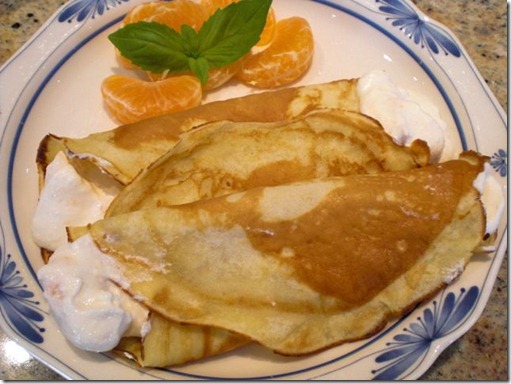
Next weekend, we had similar crepe but with a slight variation.
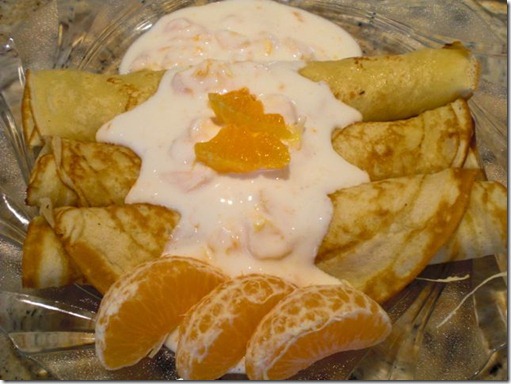
As usual, my wife made the batter and I cooked the pancakes.
Ingredients for crepe batter:
3/4 cup All purpose flour
1/2 Tsp. salt
1 Tsp. double-acting baking powder
2 Tbs. sugar
2 Eggs
2/3 cup milk
1/3 cup water
1/2 Tsp. vanilla
grated lemon rind
Sift together the flour, salt and baking powder and set aside. Mix together the sugar, eggs, milk, water and vanilla (make sure the sugar dissolves completely). Mix the wet ingredients into the dry ingredients.
 Yogurt sauce:
Yogurt sauce:
Greek yogurt (or regular yogurt drained using cheese cloth in the refrigerator over night)
Clementine orange, peeled and cut up in small chunks
Juice of the orange, add sugar to taste
This is quite good for a relatively low fat recipe. The original recipe calls for a mixture of Mascarpone flavored with fresh orange/orange juice as the stuffing but Greek yogurt and Clementine are good substitutes. You just can’t beat the texture and lovely mouth feel of a crepe. The mild vanilla flavor of the crepe went very well with the orange flavored yogurt.
Here is the crepe we had one weekend.

Next weekend, we had similar crepe but with a slight variation.

As usual, my wife made the batter and I cooked the pancakes.
Ingredients for crepe batter:
3/4 cup All purpose flour
1/2 Tsp. salt
1 Tsp. double-acting baking powder
2 Tbs. sugar
2 Eggs
2/3 cup milk
1/3 cup water
1/2 Tsp. vanilla
grated lemon rind
Sift together the flour, salt and baking powder and set aside. Mix together the sugar, eggs, milk, water and vanilla (make sure the sugar dissolves completely). Mix the wet ingredients into the dry ingredients.
Although some recipes call for resting the batter for 5 to 6 hrs or overnight (I suppose to relax the gluten and make tender crepes), we did not do this since we were rather hungry. Add more milk or water to get proper runny consistency.
Since we do not have a special crepe pan, rake or a crepe machine, I just used our non-stick frying pan. I preheated the frying pan for few minutes and added light olive oil (the amount of oil has to be just enough to coat the bottom). When it started to shimmer (but not smoke), it is the opportune time to add the batter. The batter has to be runny enough to spread very thin and the pan has to be hot enough that the batter can be spread thinly but the portion in contact with the bottom of pan immediately starts cooking. I tilted and turned the pan to spread the batter. I took the pan on and off heat to get the right heat level (#1). When the surface looked dry, I flipped the crepe using a spatula (#2). This definitely requires some practice. Just 10-15 seconds on the last side and the crepe was done (#3). I stacked them up on the plate (#4).

Greek yogurt (or regular yogurt drained using cheese cloth in the refrigerator over night)
Clementine orange, peeled and cut up in small chunks
Juice of the orange, add sugar to taste
This is quite good for a relatively low fat recipe. The original recipe calls for a mixture of Mascarpone flavored with fresh orange/orange juice as the stuffing but Greek yogurt and Clementine are good substitutes. You just can’t beat the texture and lovely mouth feel of a crepe. The mild vanilla flavor of the crepe went very well with the orange flavored yogurt.
Tuesday, October 9, 2012
Shrimp cocktail in Hilton Head ヒルトンヘッドの茹で海老のオーロラソース
This is leftover peel and eat shrimp we made on the first evening at Hilton Head. I have posted “shrimp and grits” also made from the leftover shrimp and broth made from the discarded peels. I served this as an appetizer. Since I did not have my usual pantry, I made this sauce from whatever was available. Since we did not have appropriate vessels, I also made a cup from a half lemon.
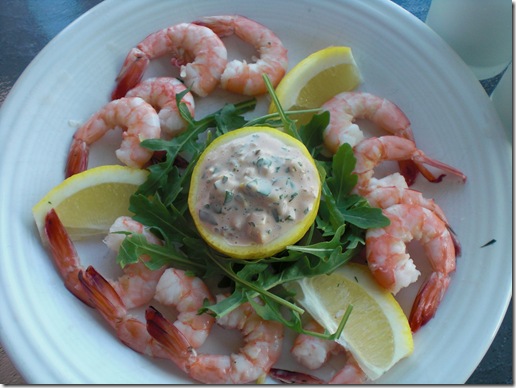
 The dipping sauce was made of mayonnaise (2tbs), ketchup (1 tbs), finely chopped sweet onion (2 tbs), finely chopped sweet pickles (1 tbs) and parsley (1 tbs), grated lemon zest (1/2 tsp) and lemon juice (1 tbs). The mixture of mayo and ketchup is popular in Japan and often referred as “aurora” sauce.
The dipping sauce was made of mayonnaise (2tbs), ketchup (1 tbs), finely chopped sweet onion (2 tbs), finely chopped sweet pickles (1 tbs) and parsley (1 tbs), grated lemon zest (1/2 tsp) and lemon juice (1 tbs). The mixture of mayo and ketchup is popular in Japan and often referred as “aurora” sauce.
I shelled the boiled shrimp and served it with wedges of lemon and baby arugula. We had this with sparkling wine from California “Domaine Chandon” Reserve Brut. (We are partial to this winery since we had several memorable times at their restaurant). The shrimp was impeccably fresh, sweet, succulent and jumbo size—almost like small lobsters. They were shrimp at their finest something we have found to be consistent here.
The fabulous shrimp were followed by a main course of fillet mignon (which was a very good cut of beef from a local gourmet grocery store) with green asparagus and my wife’s smashed potatoes. We switched to “Darioush” 2009 Cab. This was a bit on the decadent side but we were on vacation. Sitting on the balcony in the candle light (we had a combination of LED candles and real candles. The LED candles were included because the wind from the ocean sometimes makes it impossible to keep the real candle lit), watching the moon rise over the ocean, listening to the surf and looking out at the bobbing lights of the shrimping boats as well as the lights from several large freighters on the horizon heading to Savannah, we could not have had a better dinner at any restaurant.

 The dipping sauce was made of mayonnaise (2tbs), ketchup (1 tbs), finely chopped sweet onion (2 tbs), finely chopped sweet pickles (1 tbs) and parsley (1 tbs), grated lemon zest (1/2 tsp) and lemon juice (1 tbs). The mixture of mayo and ketchup is popular in Japan and often referred as “aurora” sauce.
The dipping sauce was made of mayonnaise (2tbs), ketchup (1 tbs), finely chopped sweet onion (2 tbs), finely chopped sweet pickles (1 tbs) and parsley (1 tbs), grated lemon zest (1/2 tsp) and lemon juice (1 tbs). The mixture of mayo and ketchup is popular in Japan and often referred as “aurora” sauce.I shelled the boiled shrimp and served it with wedges of lemon and baby arugula. We had this with sparkling wine from California “Domaine Chandon” Reserve Brut. (We are partial to this winery since we had several memorable times at their restaurant). The shrimp was impeccably fresh, sweet, succulent and jumbo size—almost like small lobsters. They were shrimp at their finest something we have found to be consistent here.
The fabulous shrimp were followed by a main course of fillet mignon (which was a very good cut of beef from a local gourmet grocery store) with green asparagus and my wife’s smashed potatoes. We switched to “Darioush” 2009 Cab. This was a bit on the decadent side but we were on vacation. Sitting on the balcony in the candle light (we had a combination of LED candles and real candles. The LED candles were included because the wind from the ocean sometimes makes it impossible to keep the real candle lit), watching the moon rise over the ocean, listening to the surf and looking out at the bobbing lights of the shrimping boats as well as the lights from several large freighters on the horizon heading to Savannah, we could not have had a better dinner at any restaurant.
Saturday, October 6, 2012
Shrimp and Grits シュリンプ アンド グリッツ
As usual, we were in Hilton Head island in shrimping season. One of joys of being here is the view of the ocean from our balcony including shrimping boats that come very close to the shore and, as a result, enjoying peel and eat fresh local white shrimp. The first night, we boiled up a pound and a half of white shrimp. With a good crusty bread and wine, it was dinner. Using the leftover shrimp and a broth made from the water used to boil the shrimp with the peeled skins added, we made a classic southern dish “Shrimp and Grits”.This could be a breakfast dish or ending dish for a snack dinner with wine.
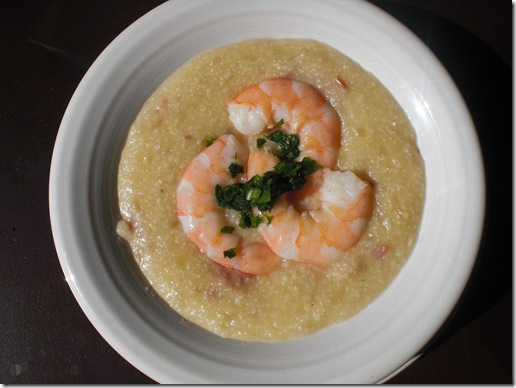
We made this in a rather simple way. Some traditional recipes suggest making Tasso ham gravy and using chicken broth to make the grits. We made the grits using the shrimp broth, ham, onion and leftover boiled shrimp. For two servings like you see above we used;
Grits – 1/4 cup Quaker oats quick (5 minutes) grits. Real stone-ground hominy (alkali-treated corn) takes too long to cook and “instant” kind does not have the right consistency.
Shrimp broth – 1 and 1/4 cup. This was salted when we boiled shrimp. Just enough saltiness that you could drink it.
Onion 1/2 medium onion, finely chopped.
Ham – two slices of good packaged ham, cut into small bite sized pieces.
My wife first sautéed the onion in a small sauce pan with olive oil (1-2 tbs) until soft and slightly browned (about 5-7 minutes), added the ham and the shrimp broth. When the broth came to a boil, she added the grits, stirred and turned down the heat to simmer for five minutes with a lid on. Then she added a tablespoon of butter and several gratings of parmesan cheese.
We served this in a small bowl with the boiled shrimp and chopped Italian parsley as a garnish.

This dish was the essence of “shrimpiness”. The grits had a lovely light fresh shrimp taste and sweetness from the broth. The broth was what really made the dish. Although we did not make Tasso ham gravy, the onion and ham added a nice dimension. Something this good can only be made with the impeccably fresh shrimp available here. Especially with the view of ocean and shrimping boats from our balcony, this was a perfect dish.

We made this in a rather simple way. Some traditional recipes suggest making Tasso ham gravy and using chicken broth to make the grits. We made the grits using the shrimp broth, ham, onion and leftover boiled shrimp. For two servings like you see above we used;
Grits – 1/4 cup Quaker oats quick (5 minutes) grits. Real stone-ground hominy (alkali-treated corn) takes too long to cook and “instant” kind does not have the right consistency.
Shrimp broth – 1 and 1/4 cup. This was salted when we boiled shrimp. Just enough saltiness that you could drink it.
Onion 1/2 medium onion, finely chopped.
Ham – two slices of good packaged ham, cut into small bite sized pieces.
My wife first sautéed the onion in a small sauce pan with olive oil (1-2 tbs) until soft and slightly browned (about 5-7 minutes), added the ham and the shrimp broth. When the broth came to a boil, she added the grits, stirred and turned down the heat to simmer for five minutes with a lid on. Then she added a tablespoon of butter and several gratings of parmesan cheese.
We served this in a small bowl with the boiled shrimp and chopped Italian parsley as a garnish.

This dish was the essence of “shrimpiness”. The grits had a lovely light fresh shrimp taste and sweetness from the broth. The broth was what really made the dish. Although we did not make Tasso ham gravy, the onion and ham added a nice dimension. Something this good can only be made with the impeccably fresh shrimp available here. Especially with the view of ocean and shrimping boats from our balcony, this was a perfect dish.
Tuesday, May 22, 2012
Anchovy and black pepper cookies アンチョビ黒胡椒クッキー
One weekend, my wife was looking through a cookbook titled "500 appetizers". She disappeared into the kitchen and came back with "Anchovy and olive tepanade cheese dip". I asked how many anchovies she used knowing how hard it is to use up an entire tin of anchovies. She said the can was empty but I had to wait until tomorrow. The result is shown below. It looks like a perfectly innocent sweet butter cookie but it delivers quite a surprise. It has the texture and crumb of a sugar cookie but it is savory; with the pleasant salty taste of anchovy, pepper and Parmesan cheese. This is certainly not for desert or an afternoon snack but goes surprisingly well with red wine.
I asked my wife for the recipe.

The cookie dough: 1/2 cup all-purpose flour, 1/4 cup butter chilled, 1/3 cup freshly ground Parmesan cheese, 3 anchovies drained, 1/2 tsp. ground black pepper. Process in a food processor until the ingredients come together into a dough. Make into a ball, cover with plastic wrap and refrigerate (my wife chilled it over night). Roll out the dough to about 1/2 inch thick (picture 1) and cut into various shapes with a cookie cutter (picture 2). Put on a lightly greased cookie sheet (picture 3) and bake in a 400 degree oven for about 6 minutes until golden brown (picture 4).
I asked my wife for the recipe.
These are not the cookies to serve with coffee to the bridge club, but as an hors o'dourve accompanied with a full bodied red wine they are very special.
Thursday, April 5, 2012
Small Japanese covered containers 珍味入れ
Last time we were in Kyoto, somehow we ended up in the Nishiki Market 錦市場 early in the morning. Many stores just opened or were getting ready to open up. My wife spotted a small china store. The middle aged man, who apparently was the owner, was still unpacking the items in front of the store. He had a very extensive collection of small covered containers which Japanese like to use to serve a small portion of "extraordinary tastes" or "chinmi" 珍味. He even unpacked more of these containers for her. These are six she chose (I sanctioned the limit to 6). Some are spheres with a concetric ring pattern or with plum flowers. She chose two of the spheres with concentric ring pattern since she really liked it. She chose one of each for others. The owner said this happened to be the most popular item and praised my wife's keen eye and good taste but I had a feeling if she liked other container he would have made that one most popular. In any case, we hand carried all these contianers and boxes home on the airplane. Somehow, I completely forgot that we had this. I was pleasantly surprised when I found them in the back of the cupboard.

Nothing new here, but I served squid marinated in mirin and soy sauce or "Okizuke" 沖漬け(left), Ikura salmon roe in cucumber cup and garnished with salted kelp (center) and "mozuku" sea weed in sweet vinegar (right). All prepackaged, I just thawed and arranged.
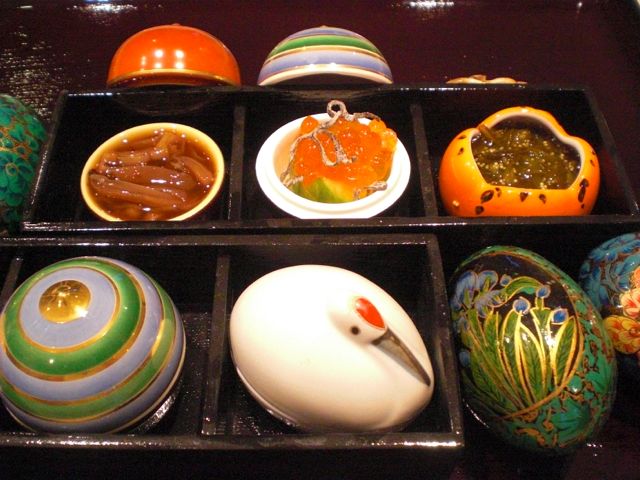
These are nice containers to have, especially if you are into serving drinking snacks for sake like we are. Only problem is that all these containers need to be hand washed and it is easy to break (we have not, yet). By the way, the picture shows some lacquered easter eggs that my wife collected. She thought they were seasonal and added them to the picture.
Saturday, December 31, 2011
Packaged drinking snacks #2 出来合の酒のつまみ パート2
This is the last post of 2011. It will be the year of the dragon next year. Although this may not be a worthy ending of 2011, this is the second installment of the series on prepackaged drinking snacks from Japan. These three items are vacuum packed but not individually packaged. So, once you open up the bag, you have to finish them relatively quickly.
The left is miso flavored squid from Tsunami ravaged Iwate prefecture, the center is squid cheese rolls, the right is "toba" which is "cut" and "soft" accoding to the label.
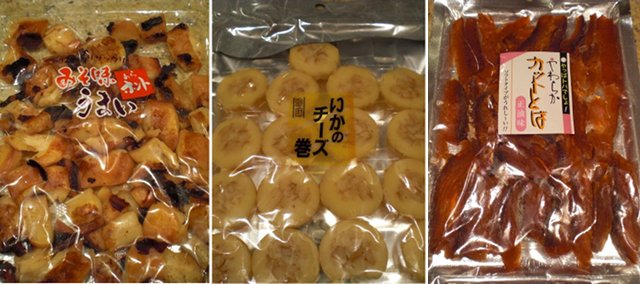
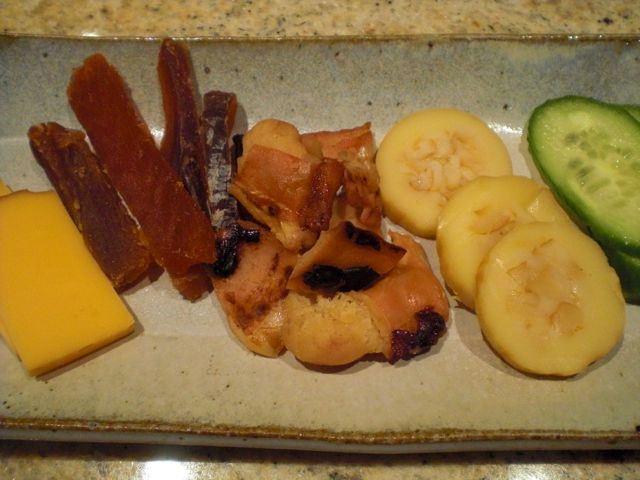 (from left to right; smoked cheddar, toba, miso flavored squid, cheese-encased squid and cucmer slices)
(from left to right; smoked cheddar, toba, miso flavored squid, cheese-encased squid and cucmer slices)
The left is miso flavored squid from Tsunami ravaged Iwate prefecture, the center is squid cheese rolls, the right is "toba" which is "cut" and "soft" accoding to the label.
I am not sure how the squid was prepared but it is semi-dry and slightly chewy with good miso flavor. The item shown in the center picture is cut-up squid encased in mild cheese (Japanese "processed" cheese). This is rather mild and soft with a very agreeable taste. The right is "soft and cut" toba. Toba とば, written in kanji ideograms as 冬葉 which means "winter leaves". This is a famous item on my home island of Hokkaido. The name, I suppose, comes from the way the strips of salted salmon drying in the cold winter wind on the bare branches of trees resembles brown leaves. Traditonal toba is usually very chewy, or sometimes hard like a strip of leather, and very salty. It is sort of the Hokkaido version of beef jerky. This version is considerably "tamed". The skin has been removed and it is cut into smaller pieces. In addition, somehow it has been made much softer, although it is still quite salty.
I served these three items with slices of smoked sharp cheddar cheese and slices of cucumber. Somehow, these drinking snacks called for scotch and water. Although we only rarely drink hard liquor now-a-days, I made a very small and weak scotch and water. Since we had not drunk scotch for such a long time, I had to hunt around to find a bottle and eventually came up with "Chivas Regal". Somehow toba goes well with scotch. Is it possible that I used to have toba with scotch in my drinking days in Susukino 薄野?
Thursday, December 29, 2011
Packaged drinking snacks #1 出来合の酒のつまみ パート1
Like mixed nuts, mini pretzels and goldfish crackers in American bars, the Japanese have a much wider array of prepackaged drinking snacks. So, when you are in Japan, in a pinch, even in your hotel room, you could have a small party without spending a fortune on room service. Drinks (beer, whiskey, chochu, sake or premixed alcoholic drinks in a can) and drinking snacks of many different kinds are available from vending machines or near-by convenience stores (you have a better choice in the latter). We received a care package from my mother. This year, for some reason, she sent different kinds of packaged drinking snacks. The four I am showing here came in a large bag but were individually wrapped. (Such double wrapping is very common for Japanese food items).
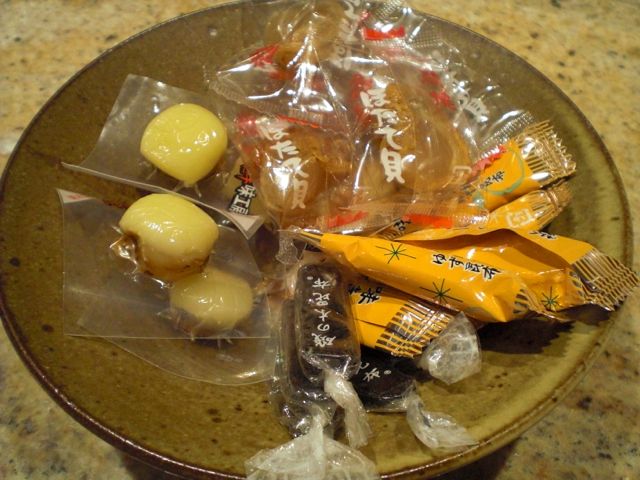 Here are the individually packaged items which can be stored at room temperature for quite some time. The below are what they look like after removing the wrappers.
Here are the individually packaged items which can be stored at room temperature for quite some time. The below are what they look like after removing the wrappers.
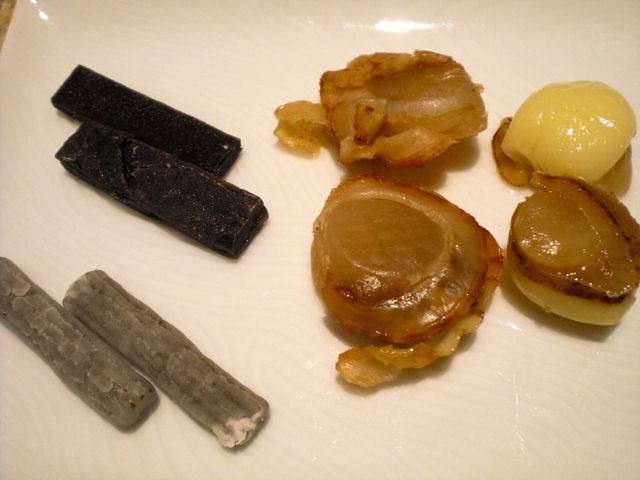 The left upper is "Iso-noki konbu" 磯の木昆布, a small layered kelp stick, which is a bit chewy but has a slight sweetness and kelp flavor (lower left in the picture below). The lower left is another kelp snack called "Yuzu-aji konbu" or yuzu-flavored kelp ゆず味昆布, a similar small kelp stick but less chewy with a nice yuzu citrus flavor (lower right in the picture below). In the center is "Iso-yaki hotate-gai" shore-grilled scallop 磯焼き帆立貝, which is a semi dried and cooked (the name implies grilled-on-the-shore) scallops. They have a nice scallop flavor but do not appear to be smoked but seasoned instead - soy sauce, mirin?? (Upper right in the picture below). Finally, on the right in the above picture is "Specail cheese hotate" スペシャル チーズ帆立, the muscle of scollop with mild cheese covering one side (Left upper in the picture below). This one is not as strongly flavored as the shore-grilled scallop.
The left upper is "Iso-noki konbu" 磯の木昆布, a small layered kelp stick, which is a bit chewy but has a slight sweetness and kelp flavor (lower left in the picture below). The lower left is another kelp snack called "Yuzu-aji konbu" or yuzu-flavored kelp ゆず味昆布, a similar small kelp stick but less chewy with a nice yuzu citrus flavor (lower right in the picture below). In the center is "Iso-yaki hotate-gai" shore-grilled scallop 磯焼き帆立貝, which is a semi dried and cooked (the name implies grilled-on-the-shore) scallops. They have a nice scallop flavor but do not appear to be smoked but seasoned instead - soy sauce, mirin?? (Upper right in the picture below). Finally, on the right in the above picture is "Specail cheese hotate" スペシャル チーズ帆立, the muscle of scollop with mild cheese covering one side (Left upper in the picture below). This one is not as strongly flavored as the shore-grilled scallop.
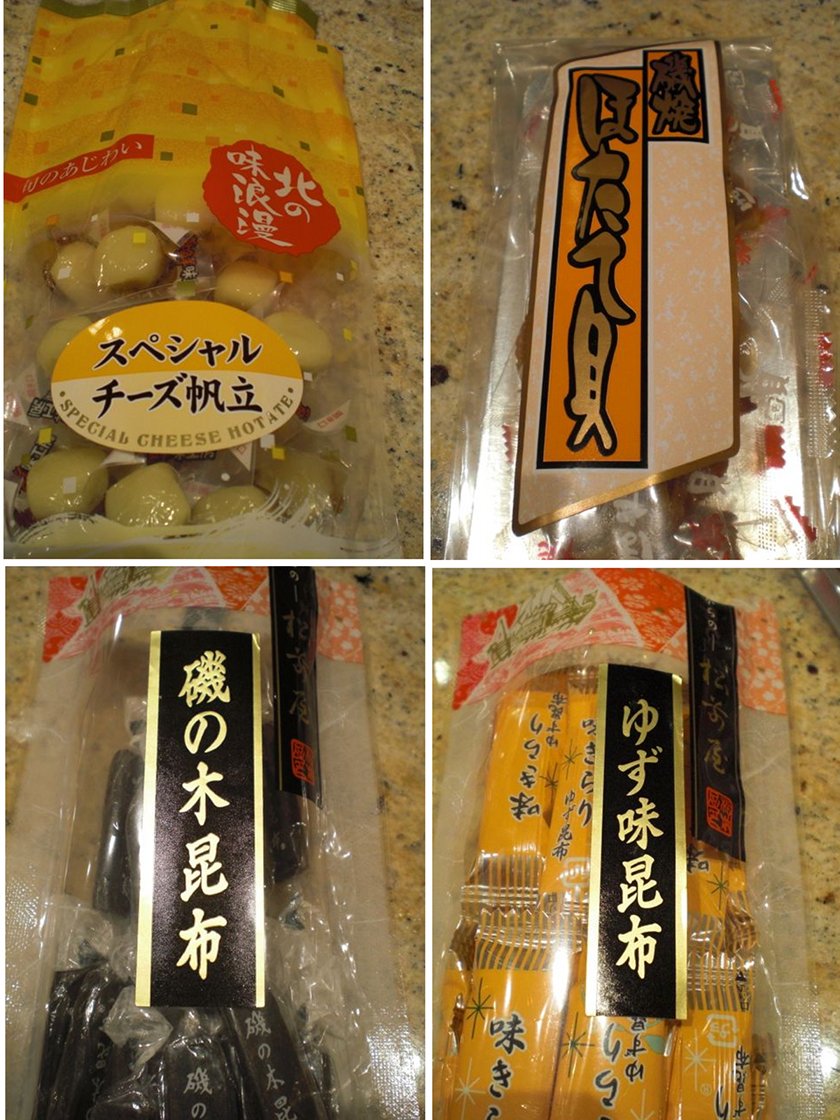 These snacks are much more interesting and tasty (and sometimes chewy) than their American counterparts. It is very convenient as a drinking snack while you are making something else for your drink. My wife liked the yu-zu flavored kelp stick the best followed by the cheese covered scallop. I was more partial to the two scallop snacks. Whichever snacks we preferred, we both ended up drinking quantities of water--because although individually they are pleasingly seasoned cumulatively we felt we had eaten a lot of salt.
These snacks are much more interesting and tasty (and sometimes chewy) than their American counterparts. It is very convenient as a drinking snack while you are making something else for your drink. My wife liked the yu-zu flavored kelp stick the best followed by the cheese covered scallop. I was more partial to the two scallop snacks. Whichever snacks we preferred, we both ended up drinking quantities of water--because although individually they are pleasingly seasoned cumulatively we felt we had eaten a lot of salt.
Friday, October 14, 2011
Boiled Chestnuts 茹で栗
This is continuation of the North American chestnut theme derived from the chestnuts I mail ordered from a farm in California. The chestnut rice was a success. I decided to just simply boil the chestnuts since this was the most common way I enjoyed them as a kid in Japan and we collected chestnuts from the neighborhood chestnut trees.
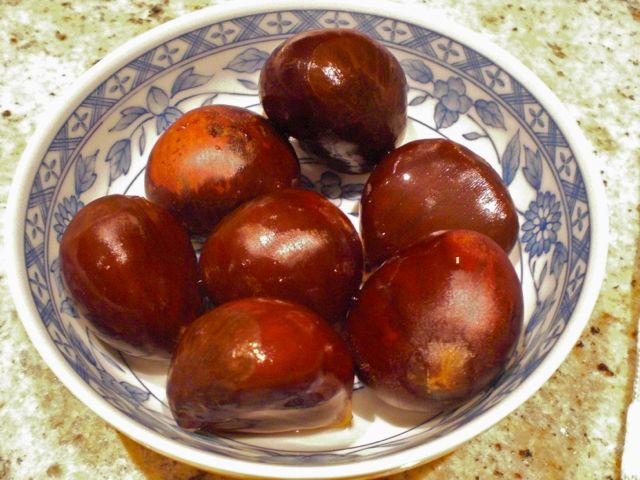
Obviously my mother cooked the chestnuts when I was a kid and I do not remember how long she cooked them. The pamphlet that came with the chestnuts had some information but I decided to do a web search and settled on this method.
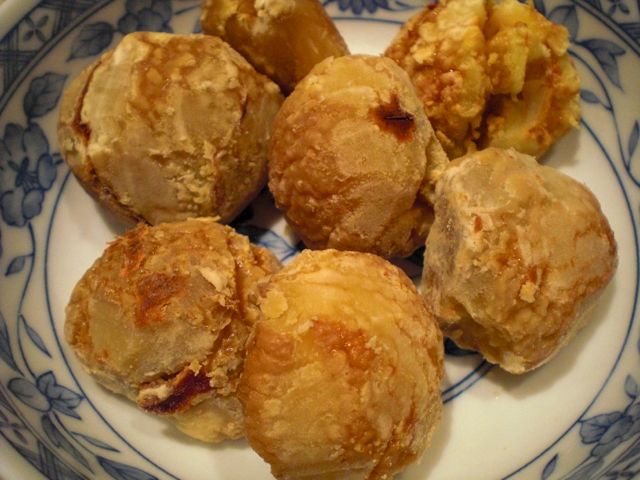
When I was a kid, everybody peeled their own chestnuts. My mother would serve them in a big bowl and we all sat around the table peeling and eating. Since I was dealing with a chestnut amateur (my wife) I did the peeling before I served them. I peeled the outer skin as well as the inner skin (Picture above). It was not too difficult to remove these two layers of skins.
I first soaked the chestnuts in cold water just enough to cover for several hours (close to 6 hours). I poured the water to just covered the chestnuts, then added a pinch of salt. I placed the pot on a medium flame. As soon as the water started boiling, I tuned it down to simmer with the lid on. I boiled it for 40 minutes mixing the chestnuts once during the cooking. I let it sit in the pot until the water cooled to room temperature and then drained (Picture above).
This was very good. The natural sweetness of the chestnuts was very nice with an almost starchy consistency. I told my wife that I did not remember when I last tasted boiled chestnuts. She replied that she had nothing to remember since she never had boiled chestnuts and certainly nothing related to chestnuts that tasted this good. Surprisingly, the chestnuts went very well with the red we were drinking (100% tempranillo from Spain), Bodegas Resalte de Penafiel Ribera del Duero Crianza 2005. This is interesting pairing and we rather enjoyed it.
Friday, January 21, 2011
Stuffing cake スタッフィングのケーキ
This is a mere leftover control dish but it tasted pretty good. We had leftover stuffing which my wife made for Christmas. I needed a shine dish to end a meal and this was a perfect solution.
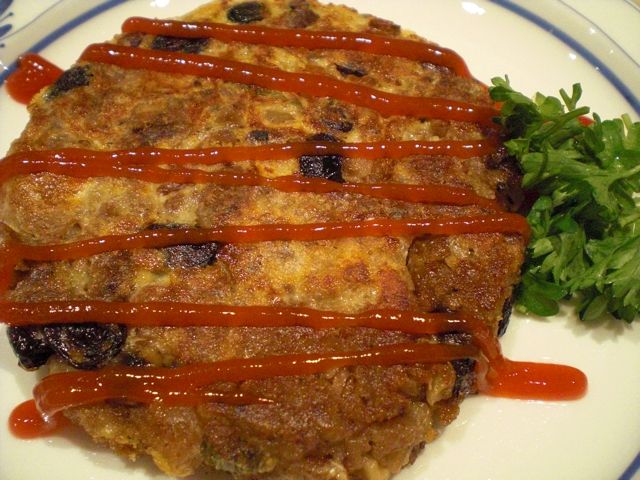
I added one beaten egg to whatever amount of the leftover stuffing we had. I melted butter and placed two ring molds in a frying pan on a medium-low flame. I made two thin disks (1/2 inch) of the stuffing by pressing it firmly into the ring molds using a silicon spatula. I fried one side for one to two minutes. I then removed the molds (the disks should hold shape) and flipped them over and cooked the other side for 1 more minute. I garnished it with good old fashioned American ketchup. This retained the stuffing taste but had a nice crunchy crust while still being moist on the inside. It is a quite nice "shime" 締め or ending dish.
Sunday, May 16, 2010
Cocktail カクテル
We very rarely drink hard liquor or cocktails nowadays. Red wine and sake are more agreeable most of the time. But if the occasion calls for it like today, we enjoy a cocktail. I usually go for a Martini and my wife for a Manhattan. I think that, the quality of the gin, bourbon, and vermouth or whatever you are using is, of course, important. There are other very important details that make the cocktails especially good. The first is the glass. It has to be a very thin rimmed crystal so that when it touches your lip, it gives you a nice sensation. A thick cheap cocktail glass actually made of glass does not do it. Second, the glass and the ingredients have to be very cold. I chill the glasses by pouring crushed ice mixed with cold water into them first. Using a cocktail shaker with enough crushed ice (-10F ice from a freezer is better than ice from a stand alone ice maker some establishments may use, which is not as cold) is also important so that the cocktail is super cold. Tiny ice crystals should float on the surface when poured. Third, the garnish--a good stuffed green olive for the Martini and maraschino cherries for the Manhattan. In the case of my wife, make that two maraschino cherries. (Its a long story having to do with good family times, and the distribution, to the kids, of Maraschino cherries, one each, from a Grandma and Grandpa who liked Manhattans but not the Maraschino's that came in them). Of course instead of having a cocktail in a dark and smoky bar, we like to have it in our backyard on the weekend when the weather is perfect--sunny, cool and no mosquitoes, like today. We had small canapes of creme fraiche, capers and smoked salmon on small squares of Pumpernickel with the cocktails. We had to admit, though, if there is a nice Izakaya nearby like this one, we may change our mind and venue (especially if it was a weekday evening).
Subscribe to:
Posts (Atom)









